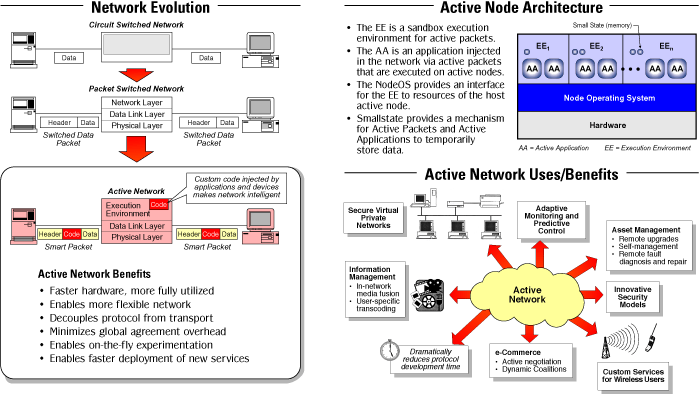

|
|
|
Atropos: The Active Network Management Prediction Toolkit
The Atropos (formerly AVNMP) Toolkit allows experimentation with predictive capability inside a network while the network is operating: this might be best described as 'in vitro' prediction experimentation. The purpose of this tool is to facilitate experimentation towards addressing a severe limitation in state-of-the-art network management: current management techniques are reactive. The toolkit is an active application that executes in real time within a network that has an overlay active network. Active networking provides a framework in which executable code within data packets executes upon intermediate network nodes. The Atropos Toolkit provides the infrastructure to develop and inject numerous, small, interacting network component models in support of network prediction. Research results in Complexity Theory using Atropos can be found in the DARPA funded GE Fault Tolerant Networking Project .
Atropos models injected into the network allow network state to be predicted and efficiently propagated throughout the active network enabling the network to operate simultaneously in real time as well as project the future state of the network. Network state information, such as load, capacity, security, mobility, faults, and other state information with supporting models, is automatically available for use by the management system with current values and with values expected to exist in the future. In the current version, sample load and processor usage prediction applications have been experimentally validated using the Atropos Toolkit. The toolkit's distributed simulation infrastructure takes advantage of parallel processing within the network, because computation occurs concurrently at all participating active nodes. The network being emulated can be queried in real time to verify the prediction accuracy. Measures such as rollbacks are taken to keep the simulation in line with actual performance.
The Atropos Toolkit allows experimentation with parameters involved in the tradeoff between prediction accuracy, computation, memory, and bandwidth overhead, and length of the prediction look-ahead window in order to optimize the demand for predictive accuracy at a particular active node. Thus Atropos facilitates experimentation in a distributed, active, and truly proactive network management environment. It enables users to generate "What if...?" scenarios and make them an integral part of the network as it operates. The toolkit provides a solution for a highly dynamic, intensely computational operation that in the past has hindered management software from incorporating prediction capabilities.
The steps for downloading and installing Atropos (formerly AVNMP) are provided below. Atropos is currently implemented using the Magician Execution Environment. Magician is a Java-based environment that can be used to define and deploy an active network overlay on an existing network of distributed workstations. It also enables users to rapidly create active applications to execute on the overlay active network.
The first figure shows the concept of an active network; code travels in the packets along with data. The code is capable of dynamically integrating itself with the operation of a network device through the Execution Environment (EE). In the case of Atropos, the code provides a thin layer of mirroring capability allowing network components to maintain future state. In this tutorial, LoadGen in Chapter 4 is an active AA whose load we predict using Atropos.

In the next figure, the Atropos Active Application (AA) is injected in to
the active network allowing intermediate network devices to operate
ahead of wallclock time as shown by the Virtual System plane that resides
above the Real System. This is accomplished by injecting component models
of the actual devices (Physical Processes (PP)) into the network. The physical
processes are wrapped in a Logical Process (LP) that handles synchronization
and rollback at individual that may be due to messages received out-of-order
or prediction error that exceeds a preset tolerance. The only requirement
for adding prediction capability for additional attributes or devices is to
learn how to develop Atropos physical process models. Learning how to use
the Atropos toolkit to build and test predictive component models is the
focus of this tutorial. In this tutorial, LoadGen is the AA that generates
the load that Atropos is challanged to predict. Notice in the figure below
that an SNMP MIB sits between the Atropos PP and the Active Application. Both
the predicted state and the information required by Atropos to perform the
prediction is stored in the SNMP MIB. Chapter 5 and 6 of the tutorial discusses
how to interface the Atropos toolkit with a the SNMP MIB. Chapter 7 explains
the Atropos Driving Process (DP) which generates predictive active messages.
In Chapter 8 the Logical and Physical Process model are explained. Finally,
Chapter 9 explains how to run the system and gather statistics on the internal
prediction efficiency.
Books

|
Active Networks and Active Network Management: A Proactive Management Framework by Stephen F. Bush and Amit Kulkarni, Kluwer Academic/Plenum Publishers, New York, Boston, Dordrecht, London, Moscow, 2001, 196 pp. Hardbound, ISBN 0-306-46560-4 |
| Please add yourself to the Atropos email list. (optional) | ||
| Download the latest release of the Atropos source code. (required) | ||
| Here is the CVS View of the Atropos source code. (for developer contribution to Atropos code) | ||
| General Atropos Developers' and Users' information. (general information) | ||
|
||
|
Disclaimer: General Electric Company make no warranties regarding the following software, including the implies warranties of MERCHANTABILITY or FITNESS FOR A PARTICULAR PURPOSE, and by downloading this software users agree to indemnify General Electric against any liability caused by or relating to their use of the software. |